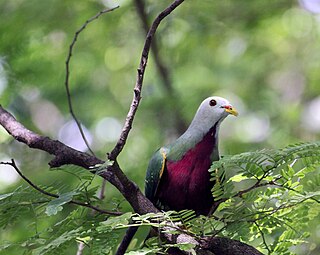
Vitex agnus-castus is a plant native of the Mediterranean region. It is one of the few temperate-zone species of Vitex, which is on the whole a genus of tropical and subtropical flowering plants. Theophrastus mentioned the shrub several times, as agnos (άγνος) in Enquiry into Plants. It has been long believed to be an anaphrodisiac – leading to its name as "chaste tree" – but its effectiveness for such action remains unproven.

The wompoo fruit dove, also known as wompoo pigeon and "magnificent fruit dove" among others, is one of the larger fruit doves native to New Guinea and eastern Australia.

Vitex is a genus of flowering plants in the sage family Lamiaceae. It has about 250 species. Common names include chaste tree or chastetree, traditionally referring to V. agnus-castus, but often applied to other species, as well.

The black hornbill is a species of bird of the hornbill family Bucerotidae. It lives in Asia in Brunei Darussalam, Indonesia, Malaysia, Singapore, Thailand.
Vitex acunae is a species of plant in the family Lamiaceae. It is endemic to Cuba. It is threatened by habitat loss.
Vitex ajugaeflora is a species of plant in the family Lamiaceae. It is endemic to Vietnam.
Vitex amaniensis is a species of plant in the family Lamiaceae. It is endemic to Tanzania.

Vitex cooperi is a species of plant in the family Lamiaceae. It is found in Costa Rica, Guatemala, Honduras, Nicaragua, and Panama.
Vitex evoluta is a species of plant in the family Lamiaceae. It is endemic to New Caledonia.

Vitex gaumeri is a species of plant in the family Lamiaceae. It is found in Belize, Guatemala, Honduras, and Mexico.
Vitex heptaphylla is a species of plant in the family Lamiaceae. It is found in Cuba, Dominica, the Dominican Republic, and Haiti.

Vitex keniensis is a species of plant in the family Lamiaceae.

Vitex lehmbachii is a species of plant in the family Lamiaceae. It is endemic to Cameroon. Its natural habitat is subtropical or tropical moist lowland forests. It is threatened by habitat loss.
Vitex longisepala is a species of plant in the family Lamiaceae. It is a tree endemic to Peninsular Malaysia.

Vitex parviflora is a species of plant in the family Verbenaceae, also known as smallflower chastetree or the molave tree. The name "molave" is from Spanish, derived from mulawin, the Tagalog word for the tree. It is also known as tugas in Visayan languages. It yields one of two woods from the same genus called molave wood, the other being Vitex cofassus.
Vitex urceolata is a species of plant in the family Lamiaceae. It is a tree endemic to Peninsular Malaysia. It is threatened by habitat loss.
Vitex yaundensis is a species of plant in the family Lamiaceae. It is endemic to Cameroon. Its natural habitat is subtropical or tropical moist lowland forests. It is threatened by habitat loss.
Vitex zanzibarensis is a species of plant in the family Lamiaceae. It is found in Kenya and Tanzania. It is threatened by habitat loss.

Vitex rotundifolia, the roundleaf chastetree or beach vitex, is a species of flowering plant in the sage family Lamiaceae. It is native to seashores throughout the Pacific. Its range includes continents and islands stretching from India east to Hawaii and from Korea south to Australia. This shrub typically grows approximately 1 m in height. It has a sprawling growth habit and produces runners that root regularly at nodes. This rooting pattern allows the plant to spread rapidly. At maturity, V. rotundifolia produces blue-purple flowers that are borne in clusters and ultimately yield small brown-black fruits. Its leaves are rounded at the tips with green upper surfaces and silver lower surfaces. While the plant is a seashore obligate, it grows over a wide latitude range. It has been used for medicinal purposes throughout its native range. More recently, it was imported to the eastern United States where it has become a seashore invasive. Control efforts are presently underway to protect the fragile beach dune ecosystem.
Vitex thyrsiflora is a species of woody vine in the family Lamiaceae. It is native to tropical West and Central Africa. Its hollow stem is used as a home by an aggressive species of ant.










